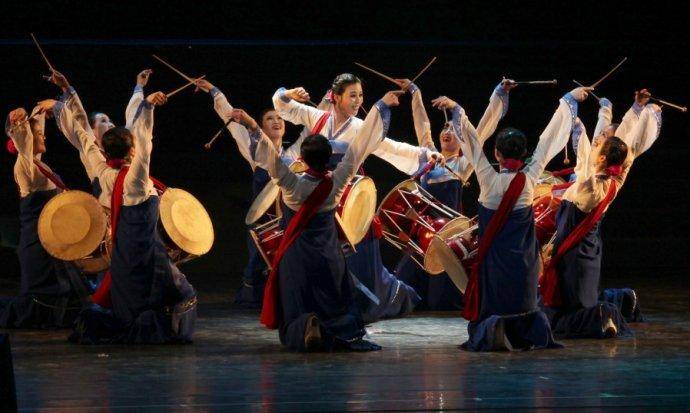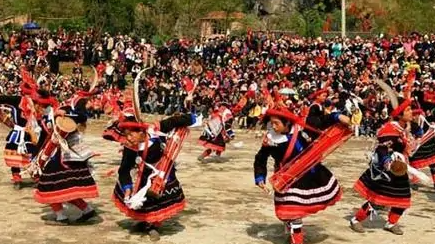Classification of long drums
285 views · Organized by 尘夕 on 2022-02-14
The most common long drums are Korean long drums, Fuzhou wolf strings, and Yao nationality long drums.
The long drum is a variant of the ancient slender drum. During the Sui and Tang Dynasties, it has been used in the nine or ten pieces of court music. Song Dynasty "Book of Music": "The stick drum and waist drum were used in the Han and Wei Dynasties. The larger ones are made of tiles, and the smaller ones are made of wood. They are all broad-headed and slender." In the 'two stick drums', both ends use sticks. Today, stick drums are held at one end with a hand." In the Yuan Dynasty, there is a record of You Xiang, "Yuan Shi·Rite and Music Records": "The stick drum is made of wood, with a slender waist, covered with skin, and a multicolored embroidered belt is placed on it.
The drum body is made of wood, cylindrical in shape, thick and hollow at both ends, and thin and solid in the middle. The full length (70-80 cm, the diameter of the drum surface is about 40 cm. The size of the drum shell at both ends is different, and the skin is also different. The thick end is covered with cowhide, horse skin or pig skin, and the thin end is covered with deerskin and white fish skin. Or dog skin, the film is framed by an iron ring, which is tightened by leather strips or ropes and can adjust the tension. The outside of the drum is painted with red paint. Due to the difference in the size of the drum shell and the thickness of the skin, two different tones can be issued. The thick end is Soft and deep bass, thin end is crisp and bright treble, generally a fourth or fifth interval relationship, and the pitch can be adjusted as needed.
When playing, sit in a seated position and place the drum on the stand; in a standing position, hang the drum in front of the player, hold the drum in the right hand to strike the thin-end drum surface, the drum is made of thin bamboo strips, about 40 cm long, and the head is Slightly larger; the left thumb rests on the edge of the thick-end drum frame and slaps with the remaining four fingers. The playing skills are rich, the left hand has four kinds of single drum, single flower, double flower and muffled drum, and the right hand has single drum, single flower, double flower, rolling, tremor and so on. The performers are often young girls between the ages of 10 and 20.
The Yao nationality long drum is finely made and has a beautiful appearance. It is mostly made of Yanzhi wood. The drum body is in the shape of a long cylinder, about 83 cm long. It is made of a whole piece of wood. The face is empty, covered with sheepskin or mountain rabbit skin. The whole body is painted with pictures such as clouds, sun and moon, dragons and phoenixes, flowers and plants or birds and beasts.
Fujian folk traditional percussion instruments, like the Korean long drum and the Zhuang bee drum, are the relics of ancient Chinese slender drums. It is often used with Fujian Opera accompaniment and Fujian folk instrumental ensemble "Cage Blowing", "Fuzhou Tea Pavilion Shifan Music", "Zhangzhou Nanci", "Shiquan Tune" and other Fujian folk music.
korean long drum
Korean long drum, also known as stick drum, two stick drums. It is popular in Yanbian Korean Autonomous Prefecture of Jilin Province and other areas inhabited by Koreans.The long drum is a variant of the ancient slender drum. During the Sui and Tang Dynasties, it has been used in the nine or ten pieces of court music. Song Dynasty "Book of Music": "The stick drum and waist drum were used in the Han and Wei Dynasties. The larger ones are made of tiles, and the smaller ones are made of wood. They are all broad-headed and slender." In the 'two stick drums', both ends use sticks. Today, stick drums are held at one end with a hand." In the Yuan Dynasty, there is a record of You Xiang, "Yuan Shi·Rite and Music Records": "The stick drum is made of wood, with a slender waist, covered with skin, and a multicolored embroidered belt is placed on it.
The drum body is made of wood, cylindrical in shape, thick and hollow at both ends, and thin and solid in the middle. The full length (70-80 cm, the diameter of the drum surface is about 40 cm. The size of the drum shell at both ends is different, and the skin is also different. The thick end is covered with cowhide, horse skin or pig skin, and the thin end is covered with deerskin and white fish skin. Or dog skin, the film is framed by an iron ring, which is tightened by leather strips or ropes and can adjust the tension. The outside of the drum is painted with red paint. Due to the difference in the size of the drum shell and the thickness of the skin, two different tones can be issued. The thick end is Soft and deep bass, thin end is crisp and bright treble, generally a fourth or fifth interval relationship, and the pitch can be adjusted as needed.
When playing, sit in a seated position and place the drum on the stand; in a standing position, hang the drum in front of the player, hold the drum in the right hand to strike the thin-end drum surface, the drum is made of thin bamboo strips, about 40 cm long, and the head is Slightly larger; the left thumb rests on the edge of the thick-end drum frame and slaps with the remaining four fingers. The playing skills are rich, the left hand has four kinds of single drum, single flower, double flower and muffled drum, and the right hand has single drum, single flower, double flower, rolling, tremor and so on. The performers are often young girls between the ages of 10 and 20.

Yao nationality long drum
The Yao nationality long drum, a thin-waisted drum spread in the Yao nationality area, is mainly used for dance accompaniment. As early as the Song Dynasty in the 12th century, the Yao people were able to make long drums. But they don't give each other away, they don't sell, and they all have them in Zhaizhai. In ancient times, it was called "Naogu" or "Bungu". In the Ming and Qing dynasties, the name of the drum was still used, and some Yao villages still call the long drum the drum.The Yao nationality long drum is finely made and has a beautiful appearance. It is mostly made of Yanzhi wood. The drum body is in the shape of a long cylinder, about 83 cm long. It is made of a whole piece of wood. The face is empty, covered with sheepskin or mountain rabbit skin. The whole body is painted with pictures such as clouds, sun and moon, dragons and phoenixes, flowers and plants or birds and beasts.

Fuzhou wolf skewers
Wolf skewers are also known as wolf tents, wolf sticks (langzhang), Fuzhou drums, Fuzhou long drums, Fujian long drums, long sticks, wolf drums, and Pongpeng drums.Fujian folk traditional percussion instruments, like the Korean long drum and the Zhuang bee drum, are the relics of ancient Chinese slender drums. It is often used with Fujian Opera accompaniment and Fujian folk instrumental ensemble "Cage Blowing", "Fuzhou Tea Pavilion Shifan Music", "Zhangzhou Nanci", "Shiquan Tune" and other Fujian folk music.
Involving musical instruments
There are three common types of long drums (pinyin: cháng gǔ), one is the Korean long drum, the other is the Yao nationality long drum, and the other is the Fuzhou wolf string. The Korean long drum is mainly popular in Yanbian Korean Autonomous Prefecture of Jilin Province and other areas inhabited by Koreans, also known as Fugu. The Yao nationality long drum has been circulated in the Song Dynasty. It is mostly made of Yanzhi wood with fine craftsmanship. It is mainly used for dance accompaniment. Fuzhou wolf string, also known as Fuzhou long drum, is a traditional Fujian folk percussion instrument, which is mostly used in Fujian folk music.
Guess you like
Organized by 赵锦辛 on 2022-03-10
With a long history, the long drum originated from the ancient slender-waisted drum. From the aspects of its shape and characteristics, popular regions and usage occasions, it has many similarities with the yellow mud drum. Its drum shape is similar to that of the public yellow mud drum.
read >>
Organized by Fucui on 2022-03-10
At the foot of Dayao Mountain in Guangxi, in northern Guangdong and southwestern Hunan, there are industrious and intelligent Yao people. Since ancient times, the Yao people have created a variety of cultural arts.
read >>
 渝公网安备 50010702504639号
渝公网安备 50010702504639号